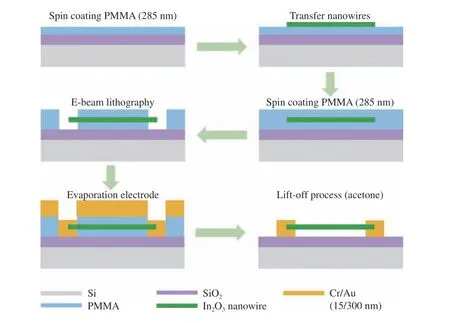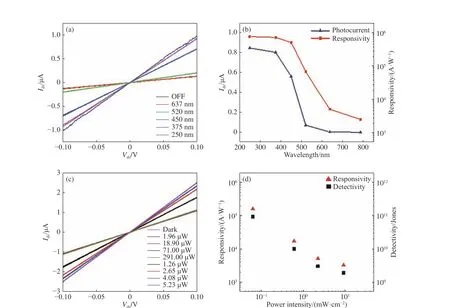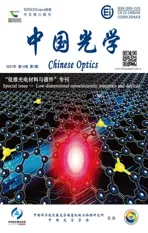悬空氧化铟纳米线晶体管制备与光电性能表征
2021-02-05姜亦杨王旭东赵东洋孟祥建王建禄
姜亦杨,陈 艳 ,王旭东,赵东洋,林 铁,沈 宏,孟祥建,汪 琳,王建禄
(1. 上海大学 材料科学与工程学院,上海 200444;2. 中国科学院 上海技术物理研究所 红外物理国家重点实验室,上海 200083)
1 Introduction
Recently, as device processing enters the nanometer scale, device development based on nano-materials has received increasing attention[1-4]. Among various technical approaches, the "bottom-up" method emphasizes the rational construction of nanofunctional devices based on atoms and molecules,which is regarded as the core of nanotechnology.Nanowire-based devices have shown great application potential in Field Effect Transistors (FETs),light-emitting diodes, sensors, nano-lasers and nanogenerators, among others[3,5-10]. In particular, III-V semiconductor nanowires are attracting great attention due to their excellent electrical and optical properties[11−12]. Among the many potential nanowire materials, In2O3nanowires possess a wide bandgap of 2.8 eV and high field-effect mobility[13]. In2O3nanowires are easy to prepare and can be produced in various ways including physical vapor deposition[14], hydrothermal methods[15], chemical vapor deposition[16], pulsed laser deposition[17]and molecular beam epitaxy[1]. Many previous studies mainly focused on the preparation and electrical properties of nanowires due to their beneficial properties such as chemical stability, excellent crystallinity, easily doping, low-cost synthesis, quantum confinement effect, and high quantum efficiency[1].However, few studies have focused on their optoelectronic properties since the first report on the ultraviolet (UV) photodetection capabilities of In2O3nanowires[18]. Despite recent advances, the performance of photodetectors still cannot meet practical demand.
This work presents a strategy to fabricate and suspend In2O3nanowire devices. Through its unique design and relatively simple manufacturing process,an In2O3nanowire channel can be separated from its substrate. The source and drain patterns are also defined by only one Electron Beam Lithography(EBL) step. Utilizing this device’s structure, we conducted an intrinsic study on the electrical characteristics of In2O3nanowire FETs, exhibiting an on/off current ratio larger than 103, a Subthreshold Swing (SS) of 241.5 mV/dec and a low dark current of ~10−13A. The calculated carrier mobility is approximately 54.6 cm2V−1s−1. The In2O3nanowire photodetector exhibits a high photoconductive gain of 4.3 × 103, a responsivity of 1.6 × 105A•W−1, and a specific detectivity of D*up to 9.3 × 1010Jones at a low power density of 0.06 mW·cm−2(λ = 450nm).The response time (rise time τr), which is defined as the time for the photocurrent to increase from 10%to 90% Ipeak, is about 150ms. It is faster than In2O3nanowire-based photodetectors that have been reported previously[19−20].
2 Device fabrication and characterization
The In2O3nanowires used in this study were synthesized by Chemical Vapor Deposition (CVD)through a Vapor-Liquid-Solid (VLS) growth mechanism. A mixture of high-purity In2O3powder and graphite powder with a weight ratio of 5:1 was put into a quartz boat. A silicon substrate with a pre-deposition of 1-nm and an Au catalyst was placed downstream in the quartz tube to collect the products. A furnace was set to 1 100°C in 22min and maintained for 1 hour under a constant flow of gas (argon/oxygen = 100:1, flow rate = 200sccm).Finally, the system was left to naturally cool to room temperature. The TEM image in Fig. 1(a)shows that a large quantity of wire-like In2O3microcrystals with good uniformity was fabricated by the CVD method. The diameter of the nanowire is approximately 50nm. Fig. 1(b) and (c) show a darkfield microscopy image of the In2O3nanowire FET and three-dimensional schematic view of the suspended single In2O3nanowire photodetector. In2O3nanowires used in this research were characterized by field-emission scanning electron microscopy and high-resolution transmission electron microscopy(HR-TEM, HT7700). The SEM result is shown in Fig. 1(d), confirming that the In2O3nanowire is free of the substrate.

Fig. 1 Design and characterization of the single In2O3 nanowire device. (a) TEM of a single In2O3 nanowire. (b) Dark-field microscopy image of an In2O3 nanowire FET. (c) Three-dimensional schematic view of a suspended single In2O3 nanowire photodetector. (d) SEM of the suspended single In2O3 nanowire photodetector
To fabricate suspended nanowire devices, the key part is to find a feasible way to fabricate a structure that is both suspended and stable. We found inspiration from previous work, which wrote about electron beam lithography on both poly-methylmethacrylate (PMMA) and hydrogen silsesquioxane (HSQ)[21]. The process flow for preparing the suspended In2O3nanowire FET is shown in Fig.2(Color online). Specific steps are as follows: firstly,a layer of 280-nm-thick PMMA is spin-coated onto the Si/SiO2substrate. Secondly, In2O3nanowires are drop-casted onto the temporary layer of the spincoated photoresist. The N-doped In2O3nanowires produced by CVD have a typical length of 10μm and a diameter of less than 100nm. Thirdly another photoresist layer is spin-coated. Standard e-beam lithography is performed to define the electrodes on a marked In2O3nanowire. Then, 15 nm chromium(Cr) and 300nm gold (Au) are deposited using thermal evaporation. Finally, the fabrication of the device is finished after the lift-off process. To improve ohmic contacts, devices were annealed at 200°C in Ar atmosphere for 2hours.

Fig. 2Fabrication process of suspended nanowire devices
3 Results and discussion
The electrical properties of fabricated suspended In2O3transistors are investigated with a Lake Shore Probe Station together with an Agilent B1500(Agilent Technologies, Santa Clara, CA, USA)semiconductor parameter analyzer. The I–V curves of the nanowire-based photodetector are shown in Fig. 3(a) (Color online) and indicate that different atmospheres can affect electrical conductivity. The annealing process can effectively improve the contact of metal electrodes. Under dark conditions, oxygen molecules tend to chemisorb onto the surface of In2O3nanowire by trapping free electrons from the conduction band and then becoming negative ions O2–, which reduces the system’s free electron density. The larger current in a vacuum is a result of the lack of oxygen in such a test environment. Fig. 3(b)(Color online) shows the typical output characteristics of the device. The liner behavior suggests good ohmic contact between the nanowires and electrodes. As shown in Figs. 3(c) and 3(d) (Color online), low dark current (approximately 10−13A) in both transfer curves can be attributed to the design of the suspended structure, which can effectively avoid the limitation of gate leakage current. Transfer curves of the same device in different atmospheres show a similar clockwise hysteresis performance. It can be confirmed that the curve does not significantly shift with an increase in drain bias for a static Vgssweep range, which suggests ideal transistor characteristics for these suspended devices in a vacuum[22]. Compared with the sharp shift of transfer curves and higher turn-off voltage in air,this suspended design suggests applications in vacuum transistors are possible. The electron mobility μFEof a single In2O3nanowire device can be calculated by using the expressionμFE= gmL2/(CgVds),where the channel length L = 2.0μm, and gm=dIds/dVgsis the transconductance of the nanowire device. Cgis the back-gate capacitance including the two parts that can be deduced based on the cylinder on-plane model: Cg1= 2πε1εrL/[ln(4h1/d)][22], where ε1εris the dielectric constant of the air, h1(200nm)is the height of suspension, and d(50nm) is the In2O3nanowire’s diameter. Cg2=2πε2εrL/[ln(4h/d)],where ε2is the permittivity of the SiO2, and h2(280nm) is the thickness of the SiO2substrate.Vgsis the voltage between drain and source. The calculated carrier mobilities of the device in air and a vacuum are 12.4 cm2V−1s−1and 54.6 cm2V−1s−1, re-spectively. The system may be influenced by contact between nanowires and metal electrodes. The SS can be expressed by the equation SS =∂Vg/∂(lgId), where Vgis the applied gate voltage and Idis the drain current. The SS value calculated in the different atmospheres is 324.7mV/dec and 241.5 mV/dec, respectively. Previous work found that performance degradation is mainly attributed to the charge accumulation in the In2O3/SiO2interface,and the gate coupling in the non-suspended structure is not as desirable as that in suspended couplings[13]. It is necessary to design gate dielectric and electrode systems to make a breakthrough in SS value limitation (60mV/dec). The device shows a high on/off ratio that is larger than 103, which implies that this suspended device has immense potential in high-performance FETs.

Fig. 3 Electric performance of the single In2O3 nanowire devices under dark conditions. (a) I-V curves of the nanowire-based photodetector in different atmospheres. (b) Output characteristics of the nanowire-based photodetector under different gate voltages. Orange arrow represent that Vg is from 20V to −50V with −10V steps. Transfer curve switch at different source-drain biases ranging from 0.1V to 1V (c) in the air and (d) in vacuum state. Black arrows represent the scanning direction of gate voltage.
The spectral responsivity is measured using a series of laser sources (250, 375, 450, 520, 637nm;Thorlabs, Inc) combined with Agilent B2902. The Ids-Vdscharacteristics of the photodetector were measured in the dark and different wavelengths of light, as shown in Fig. 4(a) (Color online). The dark current of the device is 0.12μA. The light wavelengths of 637nm and 520nm (~1.10mW·cm−2)have little influence on the device’s photocurrent compared to the dark current. Contrarily, as shown in Fig. 4(b) (Color online), the photocurrent increases drastically when the wavelength of incident light reaches to 450nm, which has comparable energy to the bandgap of In2O3(2.8 eV). The respons-ivity (R) can be defined as Iph/(PA), where Iphis the photocurrent, P is the incident power density, and A is the effective irradiated area on the nanowire.Fig. 4(b) also shows the dramatic responsivity difference (about three orders of magnitude) on either side of the wavelength corresponding to In2O3bandgap. The value of R is as large as 1.6 × 105A·W−1when incident light reaches the UV band with an applied voltage of 0.1V. The results demonstrate the excellent photoresponsivity and wavelength selectivity of the In2O3nanowire-based photodetector.The photoconductive gain (G), responsivity (R), and specific detectivity (D*) are the key parameters for evaluating the sensitivity of the photodetectors[23].

Fig. 4 Photoresponse properties of the single In2O3 nanowire devices. (a) Ids-Vds characteristics of the photodetector in the dark and different wavelengths of light. (b) Photocurrent and responsivity of the photodetector under different wavelengths of light. (c) Ids-Vds characteristics of the photodetector in the dark and different intensities of light(450nm). (d) Photoresponsivity and detectivity of the photodetector under the different intensities of light (450nm).
The corresponding external quantum efficiency (EQE) is defined as the ratio between the number of collected electrons and the number of incident photons[19]. It can be expressed by the following equation, EQE =Rhc/(eλ ). The EQE of the device is calculated to be as high as (9.9 × 107)%with irradiation of UV light (~ 200nm). The high EQE is related to the exposure of the nanowire surface via the chemisorption/photodesorption of oxygen. It has been mentioned above that by trapping free electrons from the conduction band to becoming negative O2–ions, oxygen molecules tend to chemisorb onto the surface of an In2O3nanowire in dark conditions, thereby reducing the free electron density O2(g) + e–→ O2–(ad)[19]. Electron–hole pairs are created in the bulk when illuminated with shortwavelength light. Due to the existence of new valence subbands, the photogenerated holes move from the bulk to the surface and these accumulated holes will react with the adsorbed oxygen ions, then release a captured free electron, h++ O2−(ad) →O2(g)[19]. Furthermore, separation of the structure between In2O3nanowire and substrate caused ultrahigh surface-to-volume ratios and a free-standing interface, which played an important role in high R and EQE. Figure 4(c) (Color online) shows the Ids-Vdscharacteristics for different power intensities at a wavelength of 450nm. The Ids-Vdscurve shows a linear regime with increasing Vds. It could be predicted that there will be photon-generated carrier saturation and electron-hole recombination under strong light illumination if the bias and light intensity is large enough[24-26].
The specific detectivity is an important figureof-merit characterizing the capability of the smallest detectable signal for a photodetector. Considering that the shot noise from the dark current is the major factor limiting the detectivity, the specific detectivity can be given by D*= RA′1/2/(2eIdark)1/2,where R is the responsivity, A′ is the effective area of the detector (A′ = L × d, L is the channel length, d is the nanowire’s diameter), e is the unit charge, and Idarkis the dark current. Figure 4(d) (Color online)shows the calculated values of responsivity and detectivity at different power intensities. The incident light’s power is calibrated with a PM100D power meter. It shows that R and D*increase dramatically with a decreasing light intensity, which can be caused by the trap states of the In2O3nanowires.The R and D*of the photodetector are up to 1.6 ×105A·W−1and 9.2× 1010Jones, respectively, under a low light intensity of 0.06 mW·cm−2. The highest responsivity is two orders of magnitude larger than that of commercial photodetectors based on Si,GaAs, and InGaAs[27]. Considering the small depletion of the intrinsic carriers in the nanowire channel,D*could be enhanced to up to 1015Jones if further gate dielectric and electrode structures are built (to drive dark current down from 10−6μA to 10−10μA).The photo-conductive gain (G) is defined as the ratio between the number of charges collected by the electrodes per unit of time and the number of photons absorbed by the nanowire per unit of time(G = Ne/Nph). It can be calculated as G =(Iph/e)/(PA/hν), where Iphis the photocurrent, e is the electronic charge, P is the incident power density, A is the effective irradiated area, and hν is the energy of an incident photon. The G of the photodetector is up to 4.34 × 105under a low light intensity of 0.062mW/cm−2, which is due to the long photongenerated carrier lifetime in the nanowire compared to the short carrier transit time between the electrodes[24,26,28]. High gain shows that large photocurrent output signals can be achieved with relatively low optical input.
The repeatability and response speed are also important parameters for photodetection[29]. Timeresolved photoresponse measurements were performed to characterize the response speed of the photodetector when switching a green light on and off repeatedly (520nm). The photocurrent responses under 520nm of illumination with a back gate voltage of −30V are shown in Fig. 5(a). The response time (rise time τr) and the recovery time (fall time τf), defined as the time for the photocurrent increasing (decreasing) from 10% to 90% (90% to 10%) of Ipeak(photocurrent peak), is 0.912s and 8 s,respectively. This data is extracted with a Tektronix MDO3014. It shows high stability and reliability with the on/off photoswitching behavior at Vds= 1V.As for the response speed characterization of UV light (375 nm)[25], a high-speed oscilloscope was used to monitor the fast-varying optical signal. Its longer recovery time may be related to the influence of the surface states[30]. The recombination of electrons and holes may be affected by the surface trap state of the nanowire after high-energy ultraviolet radiation. The rise time τrdrops sharply to 150ms, which is faster than previous reports for In2O3nanowires photodetectors, to our best knowledge[19-20,31]. This can be attributed to the reduction of the interaction effect between the nanowire and the substrate.

Fig. 5 Time-response characterizations of the In2O3 single-nanowire photodetector. (a) Photocurrent response of the device,where the laser light is switched on/off at an interval of 20s (520nm, 2.6 mW·cm−2 at Vds = 1V. (b) Enlargement of the curve in the 53~72s range outlined in (a). (c) A single UV photocurrent response of the device (375 nm,1.6 mW·cm−2). (d) Time-resolved photoresponse of the device showing the rise and fall time of the photocurrent at Vds = 0.1V.
4 Conclusion
In summary, we have fabricated a suspended In2O3nanowire transistor based on one-step EBL micro-nano processing technology that can stable and complete separation between a nanowire and a substrate. The intrinsic electrical transportation and photoresponse properties of In2O3nanowire FETs are studied. The In2O3nanowire transistors achieve a stable electrical property in a vacuum. Furthermore, this type of photodetector exhibits excellent optoelectronic performance including broad spectral responsivity, good repeatability, and fast response. Suspended nanowire structures provide an ideal way to investigate the intrinsic properties of nano-materials and broadens their applications in flexible and thermal isolation devices.
